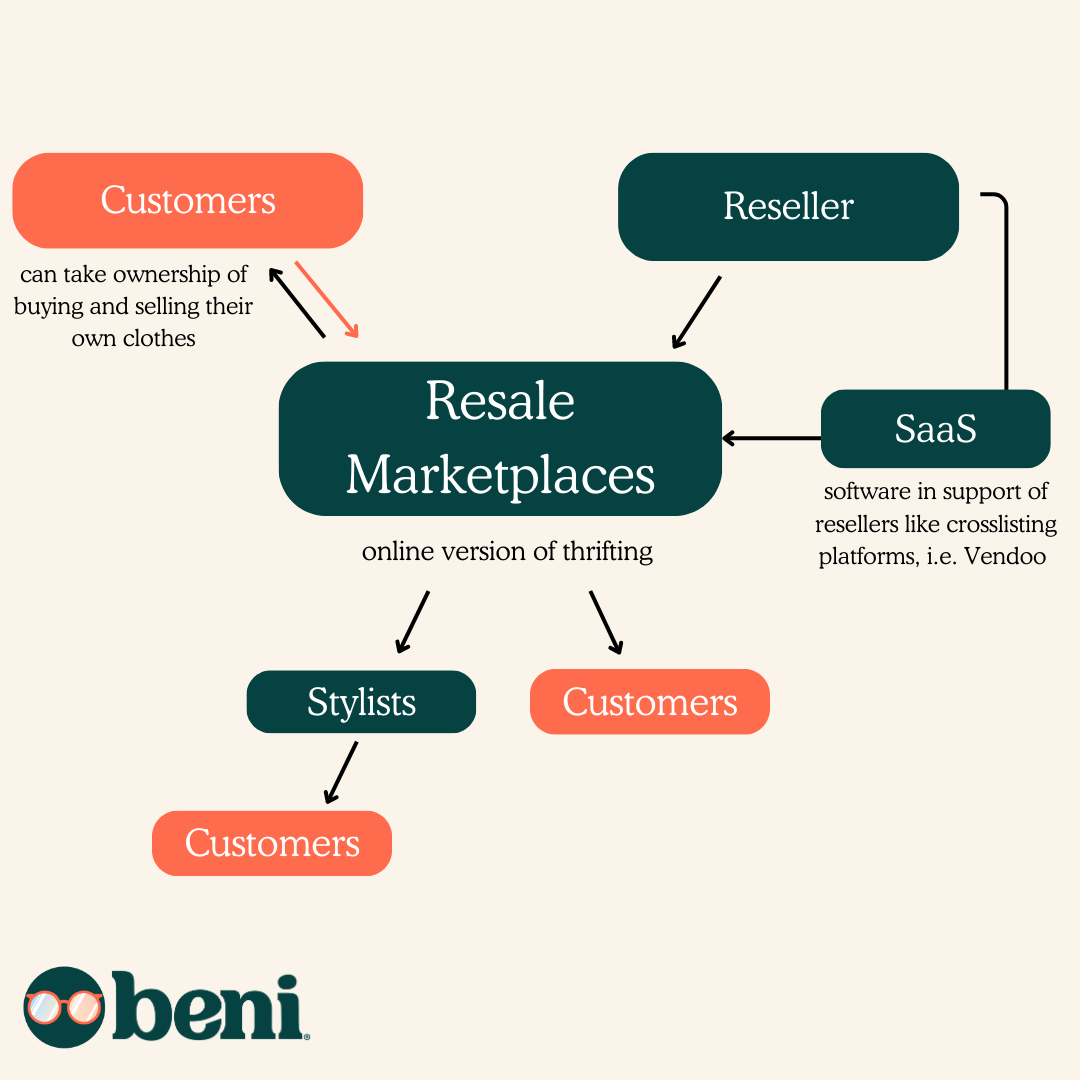Part 2: When Resale Moved Online
While thrift and donation-based secondhand stores have traditionally dominated the secondhand space, online clothing resale is the fastest-growing sector within the secondhand industry, growing two times faster than the rest of the industry. In the last five years, resale has increased in market value five times over and is largely responsible for the recent hype around secondhand. Part of the popularity of online resale marketplaces like eBay, Poshmark, and Depop is that they've allowed the average person to take control of the rehoming of their clothes which creates greater value for them.
Let's explore the business models that have taken the industry model by storm.
The Business Model
There are a couple different variations within resale marketplaces, though their key function is to help pre-loved clothing change hands without the need for brick-and-mortar buying and selling. The most popular business model is a peer-to-peer marketplace. With this model, the individual is responsible for the sale of their clothing and the marketplace offers a streamlined process and platform to do so. The individual will take the product pictures, write the descriptions, and ship out their clothes to the buyer. In exchange for providing the infrastructure and access to an audience, the marketplace will take a percentage of the sale.
Another online resale model is a managed marketplace in which the individual will send in their clothing to the marketplace facilities to process and evaluate before carrying out the rest of the selling process. This is common among higher end marketplaces because it allows the business to authenticate items and create a more consistent, trusted shopping experience. These marketplaces will take a higher percentage of the sale and function similarly to consignment models since they are the one's managing most of the selling process. Hybrids and variations of both of these models exist, too.

Industry Role
The allure of resale marketplaces is that it allows the clothing owner to capture more value for their clothing on the back-end. If the individual is willing to put in a bit of work to list their items online or send them in, they can make more money than had they used traditional thrift or consignment models. People have recognized the value and opportunity of this and the availability of resale marketplaces paved the way for a new iteration of clothing resale through individual resellers. We will dig into resellers more in depth next week, but marketplaces have made it easier for individuals to get involved in clothing resale as a hobby, side-gig, or even professionally.
Additionally, resale marketplaces have essentially taken thrift shopping online. The beauty of the internet in this case is access, and now anyone can score secondhand finds with the same ease as shopping from their favorite new brands. Another perk of these marketplaces is that they allow shoppers the luxury of choice and specificity. A typical in-person thrift store trip is left up to chance and the inventory available. But, shopping secondhand online allows you to access secondhand around the world with the ability to search according to your exact needs. This makes secondhand a lot more inviting and is the reason many shoppers have gotten into secondhand for the first time in recent years.
The presence of online resale has allowed the secondhand market and audience to expand greatly, both for those who are looking to add to and offload from their closets and for those wanting to leverage it as an income stream. Undoubtedly, the success and interest in resale marketplaces have inspired brands to get into resale themselves.
Major Players
The online resale OG is of course eBay, who launched shortly after the internet itself became public and continues to be one of the most used platforms. Among other top peer-to-peer marketplaces is Poshmark, Depop, Facebook Marketplace, Mercari, and Tradesy. ThredUp also is an interesting business model in the secondhand industry because they transcend several business models including operating as a managed online resale marketplace. Luxury marketplaces include the RealReal, Vestiaire Collective, and Farfetch. There are also specialty marketplaces that focus on a specific category like streetwear (GOAT), wedding (Still White & Nearly Newlywed), or kids (Kidizen).
For a more detailed look at resale marketplace businesses, see our breakdown here.

Opportunities & Challenges
One of the biggest challenges for resale marketplaces is streamlining, especially for managed platforms. It requires unique systems and inventory management to sell secondhand at scale. Because there isn't item consistency, each article of clothing has to be photographed and listed for sale separately which is really hard to do efficiently and requires a lot more time and manpower. These scaling dilemmas mean many resale marketplaces struggle to become or stay profitable. Perhaps these struggles can be attributed to growing pains and will work themselves out as this sector matures and evolves.
While efficiencies can be tricky, resale marketplaces have already created so much opportunity within the secondhand industry. Even the challenges of scale present opportunities for new businesses and innovations to enter the market. Both software as a service (SaaS) and resale as a service (RaaS) models can support the expansion of resale and address inefficiencies. AI and smart tagging of clothing (imagine a clothing tag that could be scanned and could auto populate a secondhand listing with its own description and details) are ideas currently being explored to make selling secondhand easier.
With more than enough secondhand to go around and billions of new items of clothing still being produced every year, we are far from market saturation. New resale marketplaces entering the market have the potential to keep specializing and tailoring their offerings and experiences to create a more “branded” experience without being a brand that produces new apparel at all. The beauty of resale is that there is more consumer investment in the experience because customers can also be contributors and co-creators in the model.
Online resale has served as the catalyst for many of the shifts, excitement, and innovation in secondhand over the last several years. It will be exciting to continue to watch how it pushes the industry forward and who else is invited to join!
We’re looking for industry thought leaders to talk to as we continue this series — if you’re interested or know someone who would be a good fit, please reach out!



